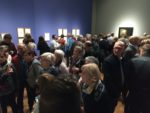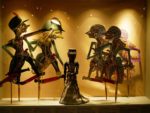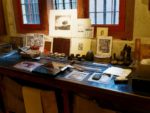To download a printable PDF version (no pictures)
click on this link E2E2019no2.pdf (four A4 pages)
These are links to photographs of our visit to Amsterdam
(photography was forbidden in the Van Gogh Museum) and
our restaurant meals
Last week the postman delivered two identical heavy envelopes. They contained French EU election literature from fifteen of the thirty-four alliances of political groupings who could afford to print their manifestos and lists of candidates. The overwhelming impression was of anti-Macron sentiments, not to mention anti-European sentiments.
For example the UPR’s (Union Populaire Republicain) slogan is Ensemble pour le Frexit, while the list of the Patriotes, Gilet Jaunes and Citoyens included a picture of their main man with their ally and supporter Nigel Farage under the injunction Quiter l’UE: nos allies le font! There is a new voting system this year in France, voting for national rather than regional representatives. There are currently 74 seats to fill (79 after redistribution following Brexit, so 5 virtual seats till then). Some lists indicate the region the candidates are from, with our region, Grand Est, providing a distressing number of Marine Le Pen’s Rassemblement National list (slogan Prenez le pouvoir); she also has a candidate from French Polynesia, as does Debout la France (slogan Le courage de defendre les Francais). Interesting times ahead. Voting here takes place as we travel back to the UK for half-term. We won’t be in E2E to vote and there is no postal vote option, only voting by a proxy.
When we travelled back to the UK at the beginning of April, the Brexit extension was still to be agreed. We broke the journey at Arras, and enjoyed strolling round the town on one of those sunny April evenings, with the beautiful big squares filled with people sitting outside at bar and cafe tables. At Calais next day, officials seemed to be shrugging their shoulders at the port: no armed soldiers checking cars and no passport check queues.
As political discussions unfolded, we enjoyed seeing family and friends. John helped Leila buy a secondhand Aygo and sorted out additional window locks, and internet-connected internal movement detectors and outside CCTV cameras to improve security following our attempted break-in. Unfortunately the already-installed alarm decided to have a late evening tantrum and set off the external alarm which could not be stopped until the bell-box battery was disconnected. We took Jacob to the Science Centre in Cambridge and visited Bletchley Park again with Ann and Derek (although we nearly didn’t get in as we’d managed to leave our tickets behind!)
On the way back from England, after passing through equally casual Dover port security, we stayed the night outside Lens and finally visited the Louvre-Lens Museum. The north of France has changed so much since those drives through slag heaps in the sixties and seventies and feels so impoverished after the closing of the mines and industries. As a regeneration project, the museum is built over a filled-in mine and is a stunning glass building with loads of wasted space, but with some very fine exhibits from the main Louvre collection in its time-line section.
Another reason for our overnight stops was to give John’s occasional dodgy back a rest on the long journey. The corset-like support belt also helps, but has the disadvantage of pressing on the bladder. This can be a problem when strolling round unfamiliar streets, as we found on our very enjoyable trip to Amsterdam the following week. We had researched the Rembrandt and Hockney-Van Gogh exhibitions and other sights we wanted to see, and also restaurants. What we had not read up on were loos and coffee shops.
On our last day, which was the finest we had planned to stroll in a leisurely fashion round the canals, the book markets and food markets. After a couple of hours we fancied a coffee and a loo. We were walking alongside a broad, picturesque canal, and went into the first coffee shop. It was packed and smoky. Not a seat in sight. And an overwhelming hash aroma. In the coffee shop next door, the indolent young man with a far away expression took pity on the two elderly tourists, focussed his attention, and explained that people bought mainly hash, not coffee, in coffee shops and we might be more comfortable looking elsewhere. We headed for a shopping street and a bakery.
There were other times when we were to feel like grumpy elderly tourists. One was at the Rijksmuseum’s brilliant exhibition of all their Rembrandts, 22 paintings, 60 drawings and more than 300 prints. It too was packed (though not smoky!), and it was infuriating how many people would just come and stand right in front of you, blocking your view of a painting or (mainly postcard-sized or smaller) etching you were looking at and take a photo with their phone about six inches from it before moving on without really looking, as if their photo was more real than the original and other viewers an inconvenient background. After a reinvigorating coffee, we returned during lunchtime, when the museum was much emptier (the tour groups having been herded off to lunch) and thoroughly enjoyed seeing the details of the pictures unhampered. And John’s birthday present to Helen was the informative book of the etchings exhibition to appreciate at leisure.
Another grumpy episode was at MOS, a Michelin-starred restaurant on the waterfront. It was a pleasure to watch the busy barges and ferries passing the window, but we began to think that, like ailing sight and hearing, our taste buds had packed up. In the pretentiously presented dishes, we couldn’t taste the described ingredients – how could the distinctive flavours of crab, asparagus and lobster be cooked away? It was a shame, as we had spent a great morning at the Van Gogh Museum starting with the Hockney-Van Gogh special exhibition, which was spacious and not at all crowded with interesting comparisons between their joy in nature.
And in the afternoon we had paid a second visit to the ethnographic Tropenmuseum, with its highly critical presentation of Dutch colonial attitudes and influences and superb artefacts from Indonesia and New Guinea. Fortunately we discovered next evening at Graham’s Kitchen that our taste buds were unimpaired, and his crab, lobster and lamb were full of flavour. If that name doesn’t sound very Dutch, its because its affable chef is from Liverpool.
It was many years since either of us had visited the Rembrandt House Museum, and we thoroughly enjoyed this visit, especially the demonstration of etching techniques and variable effects in printing. As we were queuing the conversation between a belligerent young man and his friend ran:
Why are we here?
Because I wanted to see Rembrandt’s house.
But we’ve already been here.
No we haven’t. That was the museum. This is different.
Later they had a discussion in Rembrandt’s studio with a very diplomatic attendant who admitted he had a ticket for that night’s big semi-final football match between his local team Ajax and Tottenham Hotspur. So our fellow visitors were Spurs fans doing culture. That evening, the sun came out and we walked through one of Amsterdam’s many parks (out of the town centre, fairly near our quiet hotel) to the glasshouses where there is now a good restaurant, de Kas, serving mainly home-grown food. There was a lovely atmosphere in the airy glasshouse, informative waiters, and interesting flavours. Replete we strolled back through the park and reached our hotel as the downstairs bar was exploding at half time as Ajax had scored two goals to add to their one from the first leg. 3-0. We retired to watch the second half in our room. Just as well as there must have been fury and chaos downstairs as Spurs scored an amazing three goals and reached the finals on away goals scored.
We had spent a wonderful four whole days (five nights) in Amsterdam, and could happily have spent longer. Back home the grass was long in the meadows and orchard and our enclosed vegetable patch full of weeds. We had only two weeks to create order before leaving for half-term in Letchworth. But after a week of fine weather, the grass is now cut, the potager is rotavated, and divided up into strips and paths again, seeds have been sown, broad bean and pea seedlings planted, and Helen’s birthday gift from Ann and Derek of three Lonicera caerulea (honeyberry) planted in the fruit cage. We look forward to their sweet blueberry-like flavour next year. Already, given warmth and this week’s rain, the rocket seedlings are poking through and let’s hope the rest of the seeds grow in our absence. It’s a hard life having two gardens! Maybe we need an army of robot lawnmowers snuffling permanently through our lawns/grass.
When we drove into St Dié, we discovered that during our brief trip to Amsterdam all the local roundabouts had been decorated with bicycles, many painted bright yellow, to celebrate the fifth stage of this year’s Tour de France. Riders will set out from St Dié on 10th July along a mountainous route to Colmar past sights many of you will recognise like Haut-Koenisbourg castle, Ribeauville, Kaysersberg, les Cinq Chateaux and Husseren-les-Chateaux (the castles being the give-away, since they all stand on high points). However, that day we were heading for the large annual Amnesty Book Sale. After some rummaging, John bought a French Joël Robuchon cookery book which had a good-looking recipe for chocolate-and-walnut cake.
Finding a recipe that the village traditionalists will enjoy at the Entre-deux-Eaux club’s May meeting, when Helen’s birthday falls, is always a problem as they greet foreign offerings with great suspicion. Fortunately, the brain-storming group of Sainte Marguerite pensioners are more open-minded. Last Friday it was Helen’s turn to provide the mental challenges and the refreshments afterwards. She resorted to visual rather than linguistic problems and copied a couple of battleships games from the Letchworth newspaper and some logic challenges from an old Eysenck IQ book. These were all a novelty to the group, so took a lot of concentration. The sheet of London monuments to name was less successful, so we did them out loud, along with facts about the United Kingdom, its saints and flags. By then everyone was most grateful for refreshments. John had made two dozen scones (plain and fruit) and Helen took proper plates, knives, serviettes, butter in a glass dish and a pot of home-made blackberry, apple, cinnamon and clove jam. They were an immediate success with warm congratulations being sent to the absent chef.
Today the E2E oldies afternoon was a more lugubrious affair, with much discussion of aches, urinary problems, broken bones, pharmacies and deluded villagers now in care, although Helen enjoyed games of Rummikub, Scrabble and Triominoes before the cakes and champagne were brought out and birthdays toasted. Oddly enough some of John’s chocolate-and-walnut cake, cooked according to the French recipe, remained at the end, while his cheesecake, based on English recipe, had all vanished. How does one ever know what our oldies will like?








